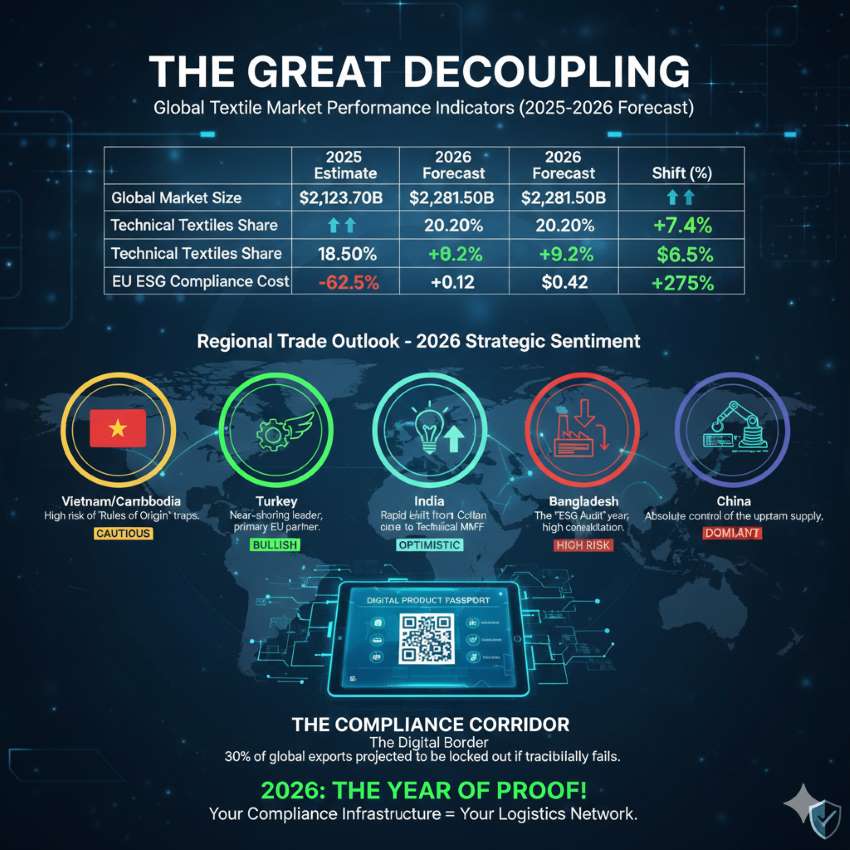FW
"The 5th Avantex Paris show, held from September 18-21, 2017 at Le Bourget, Paris, attained its goal of uniting players from fashion and innovation under one platform that provides a wealth of information, shows foresight and brings about positive change in the industry. Fashion brands, retailers and designers attended Avantex going beyond the stage of simple curiosity."
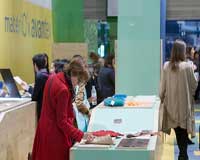
The 5th Avantex Paris show, held from September 18-21, 2017 at Le Bourget, Paris, attained its goal of uniting players from fashion and innovation under one platform that provides a wealth of information, shows foresight and brings about positive change in the industry. Fashion brands, retailers and designers attended Avantex going beyond the stage of simple curiosity.
“Avantex Paris proved to be the place where players from ready-to-wear and luxury goods were able to meet the providers of innovative, technological solutions. The variety and complementary nature of exhibitors, the daily meetings at the round tables with experts, the focus on innovative materials offered by the MateriO’ forum, the video wall, the workshops and the first session of the Avantex Fashion Pitch are all factors injecting effective and convincing stimulus in an extremely active international network for technology and fashion,” explained Michael Scherpe, president, Messe Frankfurt France.
Extensive technical textile on display
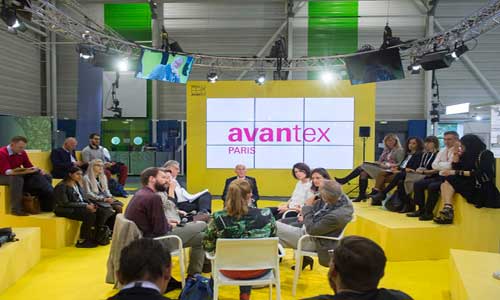
The event demonstrated the extensive range of technical textiles and finished technological products, alongside R&D projects of start-ups, who came to test their concepts in interactions with potential customers. For example, Taiwan’s Creative Tech Textile for example, which develops complex fabrics (fibres from plastic bottles and oyster shells for example) while observing style and trends. “‘Our fashion goal has been met,” said their representative Lucy Hsiao after meeting a good number of firms.
Material was the star, since the Parisian materials library matériO’, one of the trade show’s partners, presented latest developments for clothing and accessories. Future prospects forum showed supple wood-based fabrics, frog skin and fish skin leather, leather from innards, conductive fabrics, wearable sculpture and many other talking points. To & Guy showcased a revolutionary process for stylists and designers to position and test motifs on a product in 3D without needing to know every detail of the pattern.
Institutional participation
Omar Cherkaoui, Member, ESITH cluster and school, remarked, “If Morocco is chiefly considered as the country for sub-contracting, the presence of the Moroccan Technical Textiles Cluster C2TM at a trade fair like Avantex, which is dedicated to innovation, has helped to make people take a second look at what the country has to offer. Some 30 professionals showed a clear interest in our collaborative and innovative approach.” Colleges and schools, breeding grounds for tomorrow’s fashion, are delighted with the numerous contacts they made throughout the four days: Ensad Paris, the Hochschule Albstadt Sigmaringen and Chongqing University from China were able to present their research and work by their students.
Avantex Fashion Pitch, the ambitious competition held via the WiRATE platform and organised by the trade fair, rewarded start-ups that offered solutions that are representative of the segments at the show and whose products and services won the most votes. Torq Labs won the prize for Clothing & Accessories with a range of lightweight leggings for sports that help to prevent knee injuries. Pyratex, in the Material & Components category, won admission and a listing in matériO’ for its collection of fabrics in natural fibres that have beneficial effects for the skin and body. Reflect, in the Prototype Studio category, won a prize for a dedicated item in the Magazine Modelab.
The Agora at Avantex Paris, apart from the Fashion Pitch, hosted eight lectures and round tables on diverse subjects, from development of functional fabrics to the digital era, new patterns of behaviour on social media, procurement and standards for electronic textiles etc. Agora also organised the Wall of Avantex with a programme of videos about the products and projects that mix innovative technology and fashion.
"Messe Frankfurt France organized Texworld Paris from September 18 to 21, 2017. The show focused on materials, components and trimmings for the fashion and accessories industry recorded a 13.9 per cent increase in visitors compared to last year. After two years of lacklustre performance, buyers were in need of renewal and a change in fashion codes. And as Michael Scherpe, President, Messe Frankfurt France said, “We found the September 2017 show to be extremely busy. From the very first day of the show, there was a wind of change blowing through the shows."
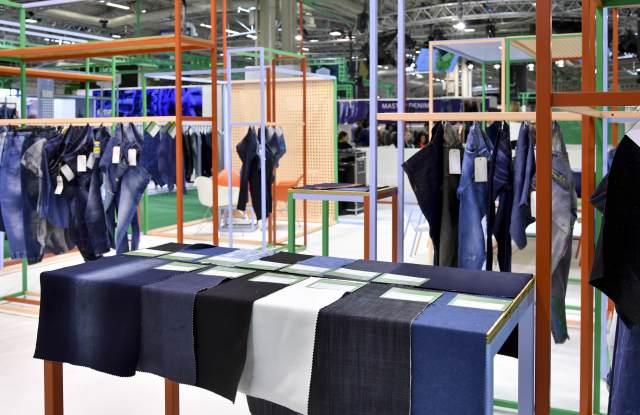
Messe Frankfurt France organized Texworld Paris from September 18 to 21, 2017. The show focused on materials, components and trimmings for the fashion and accessories industry recorded a 13.9 per cent increase in visitors compared to last year. After two years of lacklustre performance, buyers were in need of renewal and a change in fashion codes. And as Michael Scherpe, President, Messe Frankfurt France said, “We found the September 2017 show to be extremely busy. From the very first day of the show, there was a wind of change blowing through the shows. Very determined visitors descended on the General Forum for trends with its artistic backdrop, which provided an excellent showcase for the colours of the individual shows and above all the choice and original characteristics of the weavers. Exhibitors welcomed the attendance by representatives from some very high-end segments, even from the European luxury sector. The same goes for the return by Americans (+19,38 per cent for the US) and contacts who were more than satisfied as they rediscovered the show.”
Strong county participation
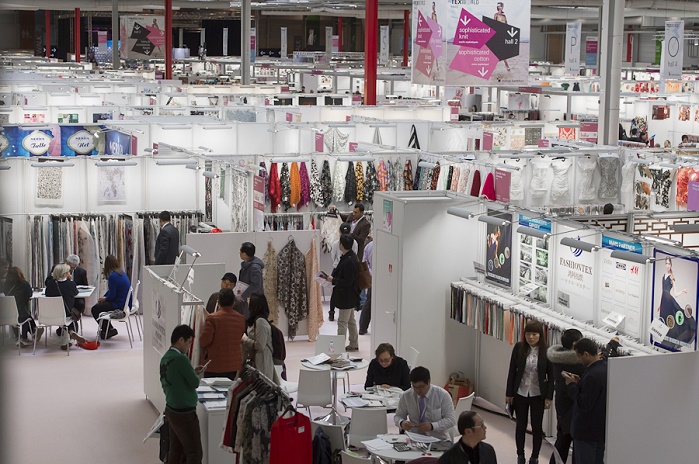
European brands remain keen on the solutions offered by the firms exhibiting at Apparel Sourcing, Avantex, Shawls & Scarves – The Accessories Showcase, Texworld Et Texworld Denim Paris (+15 per cent) and the top five countries reflect this trend: France, UK, Spain, Italy and Turkey. Germany grabbed the next spot, up by 18.7 per cent, and Belgium up by +4.8 per cent. At 83 per cent (+3 per cent) internationally, the shows at Paris Le Bourget clearly demonstrate their predominant position in global business for textiles, clothing and accessories. As Paris remains worthwhile as ever, participants have realised that they are called on to adapt to meet the demands of ‘Western’ fashion and refine their collections, their marketing strategy and the service they offer in order to increase business and become creative. The categories at the show fulfilled their purpose and the segments for embroideries, lace and elaborate knits, which attracted a good number of exhibitors, really drew the crowds.
China (with the largest contingent of weavers at the show) was one of the main attractions, as confirmed by Zhang Tao, secretary general, Ccipt Tex. The improvement in business models of domestic firms, as advocated by the Chinese government, aims to continue working towards genuine fashion products, to develop technical innovation and to emphasise sustainable development. Upscaling, was also noticed in the wide variety of products from Turkish weavers, Indian range of cotton and embroidery, South Korean prints, the comprehensive offer, even technical, from Indonesian exhibitors all drew visitors’ interest.
For businesses, Texworld Paris remains a major trade fair for the industry. September edition provided them with an opportunity to meet loyal customers face-to-face, while forging new deals. It was an unique occasion to explore the markets of the North and South American continents, as the Czech shirting specialist La Linea remarked. Business Beyond Borders, a partnership that fosters business contacts between players in the textile and clothing industry and small manufacturing firms, set up by Eurochambres, met with resounding success. They held over 200 meetings in their dedicated space involving 258 companies from 42 countries.
Texworld Denim
With almost 80 exhibitors for materials and clothing production, Texworld Denim lived up to its promise as a meeting place for businesses that is entirely dedicated to denim. Finding fabrics and manufacturers in one area made it easier for prime contractors to make contact and then conclude projects successfully from start to finish, and for exhibitors to network with each other. The Texworld Denim area is bound to expand with a marketing policy and its own trade show strategy.
Conference expanse
Three conferences and round table discussions took place at Texworld Paris: the sector for future clothing; Ex-aequo, the trends for autumn/winter 18/19; new technologies and new skillsets. The Outlook for denim in the 21st and 22nd centuries was also organised at Texworld Denim. Texworld Paris also organised fashion shows in the Catwalk area by Esmod Paris, the designers Fiona Fondadouze and Santiago Lomelli, the prize-winners from the Dinan International Festival for Young Fashion Designers, and Eymeric François’ iconic collection for 17/18. The next Texworld and Texworld Denim will be held from February 11 – 14, 2018. Be there to be a part of a bigger & better trade show.
"More than ever, the eco-efficiency of the textile & clothing industry has been under scanner with many associations taking steps towards enhancing sustainability in the apparels industry. This was the topic of discussion at the recently held exhibit in New York at Museum of Modern Art (MOMA). It focused on rethinking how businesses approach each stage of product development. Ideated by Paola Antonelli and Michelle Millar Fisher, ‘Is Fashion Modern?’ analysed the impact that items of clothing and accessories have had on the world today, including what were considered revolutionary items including, the ‘little black dress’ and Levi's 501 jeans."
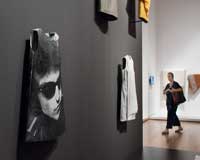
More than ever, the eco-efficiency of the textile & clothing industry has been under scanner with many associations taking steps towards enhancing sustainability in the apparels industry. This was the topic of discussion at the recently held exhibit in New York at Museum of Modern Art (MOMA). It focused on rethinking how businesses approach each stage of product development. Ideated by Paola Antonelli and Michelle Millar Fisher, ‘Is Fashion Modern?’ analysed the impact that items of clothing and accessories have had on the world today, including what were considered revolutionary items including, the ‘little black dress’ and Levi's 501 jeans. The exhibit also featured another important offering: providing a large-scale illustration depicting Glasgow Caledonian's Fair Fashion Center and a process called the Quantum Redesign of Fashion.
Sustainability taking centerstage
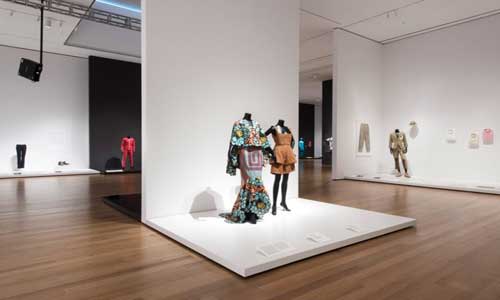
Fashion is a $2.5 trillion industry considered a top user of natural resources and polluter of the communities in which it operates. It ought to attract the attention of eco police aiming to shape a better tomorrow. MoMA exhibit used research from the Fair Fashion Center and enlisted famed data artist Giorgia Lupi to provide an important visualisation of the scope of fashion industry, especially in identifying the 16 sub-businesses that constitute the fashion system – from agriculture and chemicals to real estate and waste management. The special artwork outlined how changes in these businesses can impact other areas, but at the same time help deliver on the United Nations Sustainable Development Goals. As with many complex issues, it is envisioned that in depicting viable solutions can create an industry that is a respectful and regenerative ecosystem supporting people, planet and profits.
Quantum redesign of fashion
The Quantum Redesign of Fashion featured in this exhibit was the work stream of the Fair Fashion Center (FFC) that has developed the Quantum Redesign of Fashion, which has in just two years focussed uniquely on achieving sustainability through a profitable means and shifting the conversation to more sustainable business practices. Working with more than 237 global brands and retailers, the FFC is trying to tackle impacts created by the value chain and developing actionable solutions that align with the reality of the industry, in key issues like end of use, regenerative agriculture, circular economy, and transport.
UN’s role in fashion
The UN Global Compact recently invited a young group from Copenhagen's Youth Fashion Summit to the United Nations. The students explored how the (SDGs) allow companies to align their sustainability goals with actionable solutions: from gender equality and poverty reduction to responsible consumption and climate action. This year, the students were asked to transform their ideas for corporate action on the SDGs into a proposed UN draft resolution - the first linked to the fashion sector.
Demand for textile products made from synthetic fibers will grow by an average of 3.7 per cent per annum over 2015 and 2025 whereas consumer demand for cotton textile products will grow by only 0.2 per cent per annum. The rise in the share of non-cotton textile products reflects a significant increase in the share of textile products made from synthetic fibers. In fact, this share rose in each of the ten years to 2016 and is expected to rise further in 2017.
One reason for the rise in share is an improvement in the competitiveness of synthetic fiber prices compared with the prices of other fibers. The average price of polyester staple fiber, for instance, fell at a double digit rate in 2016 for the third consecutive year to its lowest level since 1974.
The average price of cotton, by contrast, rose in 2016 and this made cotton less competitive. In fact, 2016 was the fourth consecutive year in which the average price of cotton rose relative to the average price of synthetic fibers. However, there continues to be a preference for cotton products in industrialised countries whow account for almost 50 per cent of global consumer demand for cotton textile products.
Kingpins Amsterdam held from October 25 to 26, 2017 focused on sustainability. The first steps toward a cleaner denim industry took place where mills, fiber companies, trim suppliers and industry influencers shared a common theme: sustainability. Trims supplier Metalbottoni introduced a revolutionary jeans button entirely made in copper. The no impact, no chemical button uses copper for all three pieces which can then be recycled.
Brazilian mill Canatiba introduced a new line of fabrics called Kinder Dye, which reacts differently to chemical and physical treatments, allowing brands to purchase one fabric and achieve a multitude of effects. The cost-effective product line’s name takes inspiration from the chocolate egg with a surprise inside.
Naveena has partnered with sustainability technology firm Jeanologia to produce thirst-free H2NO denim. The sustainable technology uses air to reproduce ozone gas conditions to give fabric a worn-in, authentic appearance. This is the first time ozone is being used on the garment side of the denim process.
More people than ever asked about Lenzing’s sustainable products at the show. Lenzing saw more garment makers and laundries stop by its booth for sustainable design inspiration. The company’s latest capsule collection showcases Lenzing’s new product Refibra. In April 2018, Kingpins Amsterdam will dedicate a larger space for six to ten companies that are doing something exceptional with sustainability.
Garden Silk Mills is one of India’s leading manmade fiber-based textile companies. It is a vertically integrated manufacturer of a wide range of polyester chips, polyester filament yarns, preparatory yarns, woven (grey) fabric as well as dyed and printed saris and dress materials.
The company’s emphasis on increased product differentiation, along with better operational efficiencies, improved utilisation, timely exports and careful working capital management, has helped it to remain highly competitive and improve profitability at the operating level.
Garden has emerged as a leader in specialty chips for the polyester film industry as well as in cationic, fine denier, melange, mother yarn, nylon and spandex-based yarns. It has achieved very high performance levels in its polymerization plants leading to historically low heating costs and the highest first quality percentage on record.
Despite constantly challenging the yarn divisions with new products to be optimized, efficiency levels were very high at all its spinning and processed yarn divisions during FY17. The cost of power and fuel was reduced on account of slightly lower coal prices as compared to the previous year and improvements made in the thermic-fluid heating systems.
The company appears well positioned in its specialty chip, yarn and fabric businesses. The emphasis is on expanding its market share in differentiated products.
Mirza Salman Ispahani from Bangladesh is president of the International Cotton Association (ICA). He is the first spinner and buyer to be elected head of the global trade body and will remain in the position until 2018. Ispahani is chairman of the Pahartali Textile and Hosiery Mills. A barrister he is a former president and founder vice president of Chittagong Stock Exchange.
ICA is the world’s leading international cotton trade association and arbitral body which was formed in 1841 in UK when a group of cotton brokers created a set of bylaws and rules to help regulate the sale and purchase of raw cotton. At present, about 90 per cent of the world’s cotton is traded internationally under the bylaws and rules of ICA. It has over 550 members who represent all sectors of the supply chain. The ICA offers arbitration, training, trade and networking events, plus cotton testing and research.
He will build on this and encourage ever more transparency and closer liaison with ICA’s important growing markets in Vietnam, Indonesia and the sub-continent. He plans to expand the reach of ICA and feels there is a need for continued strategic operations and innovation at ICA.
The International Apparel and Textile Fair is being held in Dubai from November 1 to 3, 2017. The Indian pavilion comprises 51 leading manufacturers and exporters of textile and apparel who are into various product categories including: men’s wear, kids’ wear, high fashion women’s wear, technical textiles etc. They represent the best of what India is offering to the world in the textile industry.
India’s exports to the UAE during 2015-16 was 22.7 per cent of India’s garment exports to the world. Indian companies and businesses have benefited from leveraging Dubai’s position as a supply market to the Gulf and other regions. India is the UAE’s largest trading partner with exports in 2016 touchin $32 billion.
The products offered at the exhibition will be a supply base for UAE garment manufacturers. The unique proposition for both India and the UAE is that both have a well developed textile and clothing industry which can complement each other in faster growth. India has a huge export potential especially in categories such as women’s wear, kids’ wear, knitwear, home furnishings and technical textiles used in the construction industry, agriculture, medicine etc. We are in a position to promote ‘Brand India’ in the UAE and other markets in the region.
Every year, H&M burns up to 12 tons of unsold clothing. The brand says it does this if the pieces involved do not fulfill safety regulations, are mould infested, do not fulfill H&M’s strict chemical requirements or contain harmful levels of chemical products or abnormal rates of humidity.
The Swedish brand is determined that such products should not under any circumstances be either sold to customers or recycled. It says its chemical regulations go further than the law demands as it wants customers to feel totally safe while using its products. The brand also outlines what happens to its unsold merchandise: Products stopped for other reasons than health and safety are either donated to charity organisations or re-used through re-use/recycling companies.
Those products in stores that are not sold at full price are sold at a reduced price through sales. H&M also actively moves garments to stores or markets where it sees a greater demand or stores them for the next season. At a last resort, it considers external buyers of its overstock. H&M is investing significantly in the supply chain, such as in new logistics solutions with greater levels of automation, but also in optimising its lead times.
Ginning mills in Telangana have been urged to help cotton growers. Cotton growers in the state have been finding it difficult to get a fair deal because of record production this year. Now mills will be given incentives to step up cotton purchases from farmers in the market.
An exclusive delint and solvent industrial park will be set up in the state if ginning mill owners come forward and invest. A budget of Rs 1,200 crores has been allocated by Telangana’s textile sector for 2017-18. Some industrial parks will also be established with housing for workers and staff proposed within the textile parks. Telangana has achieved a year on year growth of 10.1 per cent in gross state domestic product as compared to the national average of 7.1 per cent in financial year ’17. The state has also been ranked first for ease of doing business reforms for 2015-16 by the World Bank.
Telangana is in the process of formulating a textile and apparel policy that contemplates waiver of personal loans of handloom weavers. Fresh loans are proposed to be given at three per cent interest. Subsidies will be given for capital investment and purchase of equipment by entrepreneurs. Tax incentives and power subsidies are being examined.

